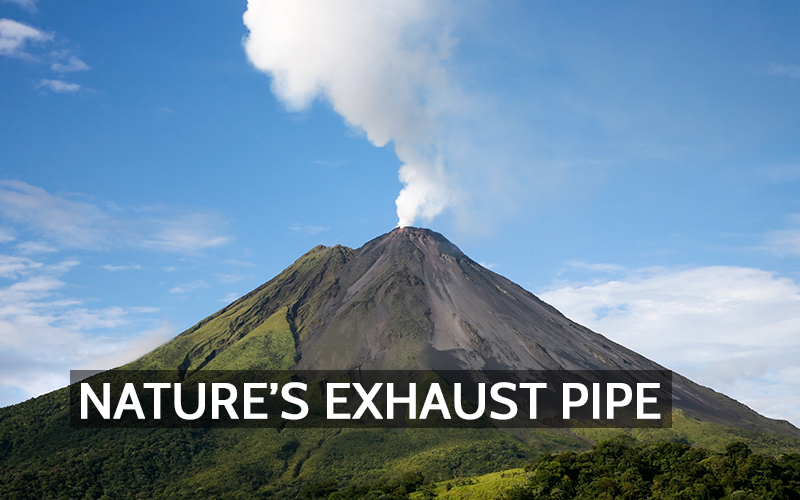Volcanoes are some of Earth’s most fascinating natural phenomena. They showcase the immense forces beneath the planet’s crust and directly influence air quality both locally and globally. Countries with active volcanoes have developed monitoring systems to manage the potential environmental and health impacts. Understanding how volcanoes affect air quality is essential for mitigating risks and protecting public health.
How Volcanoes Affect Air Quality
Volcanoes release a variety of gases and particulate matter into the atmosphere during eruptions and periods of activity. Sulfur dioxide (SO2), carbon dioxide (CO2), and hydrogen sulfide (H2S) are among the most common volcanic gases. These emissions can have immediate and long-term effects on air quality and climate.
On a local scale, volcanic emissions can pose serious health risks. Sulfur dioxide can irritate respiratory systems and, when combined with water vapor in the atmosphere, form sulfuric acid, leading to acid rain. Fine particulate matter (PM2.5) from volcanic ash can penetrate deep into the lungs, exacerbating respiratory conditions such as asthma and bronchitis.
Globally, volcanic eruptions can inject large quantities of aerosols into the stratosphere. These aerosols reflect sunlight, temporarily cooling the Earth’s surface. For example, the eruption of Mount Pinatubo in the Philippines in 1991 reduced global temperatures by about 0.5°C for nearly two years. However, these cooling effects are temporary and can disrupt weather patterns and agricultural productivity.
Monitoring Volcanoes and Air Quality
Countries with active volcanoes employ advanced technologies to monitor volcanic activity and its impact on air quality. These systems help predict eruptions, assess risks, and implement timely evacuation and mitigation measures.
- Japan Japan is home to over 100 active volcanoes, making it one of the most volcanically active countries. The Japan Meteorological Agency (JMA) monitors volcanic activity using seismic sensors, gas analyzers, and satellite imagery. For instance, they closely track Mount Sakurajima, which frequently emits ash and gases. The agency’s data supports public warnings and air quality advisories.
- Indonesia Indonesia has the highest number of active volcanoes in the world. The Center for Volcanology and Geological Hazard Mitigation (PVMBG) uses ground-based gas sensors and drones to monitor emissions from volcanoes like Mount Merapi. These technologies enable real-time analysis of air quality and help communities prepare for eruptions.
- United States In the United States, the United States Geological Survey (USGS) monitors volcanic activity, particularly in Hawaii and the Pacific Northwest. The Kilauea Volcano, known for its long-lasting eruptions, emits significant amounts of sulfur dioxide, creating “vog” (volcanic smog). The USGS collaborates with the Environmental Protection Agency (EPA) to monitor vog’s impact on air quality and public health.
- Iceland Iceland’s unique geological setting on the Mid-Atlantic Ridge makes it a hub of volcanic activity. The Icelandic Meteorological Office (IMO) tracks volcanic gas emissions, especially during eruptions like the 2010 Eyjafjallajökull event, which disrupted air travel across Europe. The IMO’s data informs air quality models and international aviation protocols.
Case Studies of Volcanic Impacts on Air Quality
- Mount Pinatubo, Philippines (1991) The eruption of Mount Pinatubo is a classic example of a volcano’s global air quality impact. The event released approximately 20 million tons of sulfur dioxide into the stratosphere, forming sulfate aerosols that spread worldwide. This led to a measurable decrease in global temperatures and a temporary thinning of the ozone layer.
- Eyjafjallajökull, Iceland (2010) Although Eyjafjallajökull’s eruption was relatively small, its fine ash particles had a disproportionate impact on air quality and aviation. The ash plume traveled across Europe, causing respiratory issues and grounding thousands of flights. This event shows the need for comprehensive air quality monitoring and international coordination.
- Kilauea, Hawaii (2018) During Kilauea’s prolonged eruption, large amounts of sulfur dioxide were released, forming vog that affected air quality across the Hawaiian Islands. Residents experienced increased respiratory issues, and local authorities issued air quality alerts. This event showed the importance of integrating air quality data into public health responses.
Mitigating the Impact of Volcanic Emissions
Effective mitigation strategies involve both technological solutions and community preparedness. Advanced gas monitoring systems and satellite imagery provide early warnings, enabling authorities to evacuate at-risk populations and issue health advisories. Public education campaigns about the health risks of volcanic emissions are crucial for building resilience in affected communities.
International collaboration is also vital. Organizations like the World Meteorological Organization (WMO) facilitate the sharing of data and best practices. For example, the Volcanic Ash Advisory Centers (VAACs) provide real-time ash plume tracking to ensure aviation safety.
Volcanoes are powerful forces of nature that shape Earth’s landscapes and influence its atmosphere. While they pose significant challenges to air quality, advances in monitoring technology and international collaboration have improved our ability to manage their impacts. Countries with active volcanoes continue to innovate, balancing the need for safety with the realities of living in volcanically active regions. Understanding and addressing the air quality impacts of volcanic activity is essential for protecting public health and the environment.
Related Article:
Houseplants and Indoor Air Quality: The Reality Behind the Green
References:


